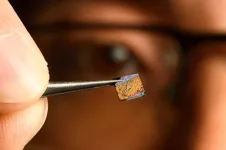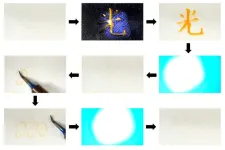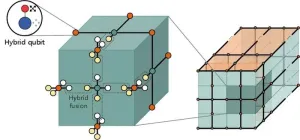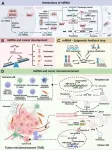(Press-News.org) With heart attacks, every second counts. A new blood test diagnoses them in minutes rather than hours and could be adapted as a tool for first responders and people at home.
“Heart attacks require immediate medical intervention in order to improve patient outcomes, but while early diagnosis is critical, it can also be very challenging—and near impossible outside of a clinical setting,” said lead author Peng Zheng, an assistant research scientist at Johns Hopkins University. “We were able to invent a new technology that can quickly and accurately establish if someone is having a heart attack.”
The proof-of-concept work, which can be modified to detect infectious diseases and cancer biomarkers, is newly published in Advanced Science.
Zheng and senior author Ishan Barman develop diagnostic tools through biophotonics, using laser light to detect biomarkers, which are bodily responses to conditions including disease. Here they used the technology to find the earliest signs in the blood that someone was having a heart attack. Though an estimated 800,000-plus people have heart attacks every year just in the United States, heart attacks remain one of the trickiest conditions to diagnose, with symptoms that vary widely and biological signals that can be subtle and easy to miss in the early stages of an attack, when medical intervention can do the most good.
People suspected of having heart attacks typically are given a combination of tests to confirm the diagnosis—usually starting with electrocardiograms to measure the electrical activity of the heart, a procedure that takes about five minutes, and blood tests to detect the hallmarks of a heart attack, where lab work can take at least an hour and often has to be repeated.
The stand-alone blood test the team created provides results in five to seven minutes. It’s also more accurate and more affordable than current methods, the researchers say.
Though created for speedy diagnostic work in a clinical setting, the test could be adapted as a hand-held tool that first responders could use in the field, or that people might even be able to use themselves at home.
“We’re talking about speed, we’re talking about accuracy, and we’re talking of the ability to perform measurements outside of a hospital,” said Barman, a bioengineer in the Department of Mechanical Engineering. “In the future we hope this could be made into a hand-held instrument like a Star Trek tricorder where you have a drop of blood and then, voilà, in a few seconds you have detection.”
The heart of the invention is a tiny chip with a groundbreaking nanostructured surface on which blood is tested. The chip’s “metasurface” enhances electric and magnetic signals during Raman spectroscopy analysis, making heart attack biomarkers visible in seconds, even in ultra-low concentrations. The tool is sensitive enough to flag heart attack biomarkers that might not be detected at all with current tests, or not detected until much later in an attack.
Though designed to diagnose heart attacks, the tool could be adapted to detect cancer and infectious diseases, the researchers say.
“There is enormous commercial potential,” Barman said. “There’s nothing that limits this platform technology.”
Next the team plans to refine the blood test and explore larger clinical trials.
Authors included Lintong Wu, Piyush Raj, Jeong Hee Kim, Santosh Paidi, all of Johns Hopkins, and Steve Semancik, of the National Institute of Standards and Technology.
END
Invention quickly detects earliest sign of heart attack
Fast, accurate blood test could speed results to physicians, first responders
2024-10-16
ELSE PRESS RELEASES FROM THIS DATE:
New research confirms that young adults can also have large vessel occlusion strokes thought to happen in older adults, given the rise of stroke risk factors in younger adults
2024-10-16
New research published in the Journal of Stroke and Cerebrovascular Diseases confirms that strokes thought to happen in older adults are possible in the younger (defined as 18-50 years old) population. Large Vessel Occlusion Acute ischemic Strokes (LVO-AIS) are considered to be the most debilitating strokes which occur due to blockage of large cerebral arteries usually from blood clots or plaque build up. LVO-AIS is typically thought to occur in older adults given that older individuals are known to have risk factors for large vessel occlusions. However, new research confirms that the younger population can have risk factors ...
Grasslands live in the climate change fast lane
2024-10-16
Although all ecosystems are affected by a changing climate, the impacts can take a while to appear. Changes in forest biodiversity, for example, are known to lag behind changes in a habitat's temperature and precipitation.
Grasslands, on the other hand, are responding to climate change almost in real time, according to new research by the University of Michigan. Put another way, forests accumulate climate debt while grasslands are paying as they go, said the study's lead authors, Kai Zhu and Yiluan Song.
"Climate change does have consequences for our ecosystems. It's going to come sooner or later," said Song, a postdoctoral fellow at the ...
Mount Sinai Doctors to present at ID Week 2024
2024-10-16
Experts in infection prevention and control at the Mount Sinai Health will present new research and insights at ID Week, the joint annual meeting of the Infectious Diseases Society of America, the Society for Healthcare Epidemiology of America, the HIV Medicine Association, the Pediatric Infectious Diseases Society, and the Society of Infectious Diseases Pharmacists in Los Angeles from October 16-19.
Mount Sinai doctors and researchers are also available for comment on breaking health news including the flu, COVID variants, HIV/AIDS, mpox, West Nile virus, measles, and fall vaccinations.
PRESENTATIONS and POSTER SESSIONS
*All abstracts and presentations ...
Rewriting the future: New molecules reversibly change with light and heat
2024-10-16
In this age of cloud storage, few people are backing up data on CD-RWs. The technology to rewrite data on compact discs was made possible by phase-change materials altered by the light and heat of lasers, though this had a limit of 1,000 rewrites. Today, scientists investigating photoswitching molecules, which change their properties when irradiated, have been finding possible applications for these materials, ranging from photopharmacology to data storage.
Osaka Metropolitan University Graduate School of Engineering student Shota Hamatani, Dr. Daichi Kitagawa, a lecturer, and Professor Seiya Kobatake synthesized aza-diarylethenes, which have nitrogen in place of carbon in a molecular structure ...
New breakthrough in quantum computing development, hybrid quantum error correction technology
2024-10-16
A major challenge in realizing quantum computers is the development of 'quantum error correction' technology. This technology offers a solution for addressing errors that occur in the qubit, the basic unit of quantum computation, and prevents them from being amplified during the computation. Without quantum error correction, it would be impossible for quantum computers to outperform classical counterparts, and thus efforts to advance this technology are ongoing worldwide.
Dr. Seung-Woo Lee's research team at the Korea ...
Unlocking the future: Information processing at the speed of light
2024-10-16
The integration of photonics into quantum computing has profound implications across various domains. As the demand for faster and more secure computational capabilities intensifies, photonic quantum computing emerges as a pivotal force, with the photonics market projected to reach USD 837.8 billion by 2025.
Harnessing the unique properties of light, photonic quantum computing revolutionizes data processing by encoding information in photons, offering unprecedented speed and efficiency for solving complex problems that traditional methods struggle to address. Photonic quantum computers can ...
A new chapter in cancer treatment: Innovative strategies and technologies of miRNA
2024-10-16
This study is led by Dr. Shiwei Duan (Department of Clinical Medicine, School of Medicine, Hangzhou City University, Hangzhou, Zhejiang, China). His team analyzed literature on miRNA, summarizing the close relationship between these small molecules and cancer. miRNA is a type of non-coding RNA that does not encode proteins, but can target more than 60% of human protein-coding genes. They play crucial roles in cell growth, differentiation, development, and apoptosis, and their dysfunction is closely linked to numerous diseases. Almost all known cancer cells have the ability to control gene expression using miRNAs, making the impact of miRNAs particularly significant ...
Silicon metasurfaces unlock broad-spectrum infrared imaging.
2024-10-16
Infrared imaging technology is crucial for advancing our understanding of the world, from exploring biological specimens to inspecting complex materials and detecting hidden patterns in physical systems. Infrared light can penetrate fog and smoke, making it invaluable for search and rescue, firefighting, and sensitive operations. Additionally, infrared imaging can enable visualising the heat emitted by objects, making it a powerful tool for night vision and security applications. While infrared cameras are valuable tools for enhanced ...
New research suggests: To get patients to accept medical AI, remind them of human biases
2024-10-16
While people are growing more accustomed to AI-driven personal assistants, customer service chatbots and even financial advisors, when it comes to healthcare, most still want it with a human touch.
Given that receiving healthcare is a deeply personal experience, it’s understandable that patients prefer it to come from, well, a person. But with AI’s vast potential to increase the quality, efficacy and efficiency of medicine, a push toward greater acceptance of artificial intelligence-driven medicine could unlock benefits ...
OIST and Partisia sign MOU to advance the research and development of multi-party computation and privacy enhancing technologies
2024-10-16
The Okinawa Institute of Science and Technology (OIST) and the Danish software company Partisia have signed a Memorandum of Understanding (MOU) to strengthen their research ties.
The primary objective of this collaboration is to advance research in Multi-Party Computation (MPC), focusing on developing innovative Privacy-Enhancing Technology solutions. By leveraging their combined knowledge and expertise, OIST and Partisia aim to deliver a global perspective on secure computation, quantum-safe cryptography, and cyber security.
OIST will contribute to the collaboration with its in-house expertise and ...
LAST 30 PRESS RELEASES:
Scientists trace microplastics in fertilizer from fields to the beach
The Lancet Obstetrics, Gynecology, & Women’s Health: Taking paracetamol during pregnancy does not increase risk of autism, ADHD or intellectual disabilities, confirms new gold-standard evidence review
Taking paracetamol during pregnancy does not increase risk of autism, ADHD or intellectual disabilities
Harm reduction vending machines in New York State expand access to overdose treatment and drug test strips, UB studies confirm
University of Phoenix releases white paper on Credit for Prior Learning as a catalyst for internal mobility and retention
Canada losing track of salmon health as climate and industrial threats mount
Molecular sieve-confined Pt-FeOx catalysts achieve highly efficient reversible hydrogen cycle of methylcyclohexane-toluene
Investment in farm productivity tools key to reducing greenhouse gas
New review highlights electrochemical pathways to recover uranium from wastewater and seawater
Hidden pollutants in shale gas development raise environmental concerns, new review finds
Discarded cigarette butts transformed into high performance energy storage materials
Researchers highlight role of alternative RNA splicing in schizophrenia
NTU Singapore scientists find new way to disarm antibiotic-resistant bacteria and restore healing in chronic wounds
Research suggests nationwide racial bias in media reporting on gun violence
Revealing the cell’s nanocourier at work
Health impacts of nursing home staffing
Public views about opioid overdose and people with opioid use disorder
Age-related changes in sperm DNA may play a role in autism risk
Ambitious model fails to explain near-death experiences, experts say
Multifaceted effects of inward foreign direct investment on new venture creation
Exploring mutations that spontaneously switch on a key brain cell receptor
Two-step genome editing enables the creation of full-length humanized mouse models
Pusan National University researchers develop light-activated tissue adhesive patch for rapid, watertight neurosurgical sealing
Study finds so-called super agers tend to have at least two key genetic advantages
Brain stimulation device cleared for ADHD in the US is overall safe but ineffective
Scientists discover natural ‘brake’ that could stop harmful inflammation
Tougher solid electrolyte advances long-sought lithium metal batteries
Experts provide policy roadmap to reduce dementia risk
New 3D imaging system could address limitations of MRI, CT and ultrasound
First-in-human drug trial lowers high blood fats
[Press-News.org] Invention quickly detects earliest sign of heart attackFast, accurate blood test could speed results to physicians, first responders






